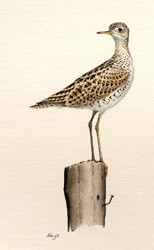Find a Bird - BBA1
Breeding Bird Atlas 1 Species Accounts
Upland Sandpiper
Bartramia longicauda
State Status
Endangered
Egg Dates
May 9 to July 6
Number of Broods
one; may re-lay if first attempt fails.

A bird of the prairies and open grasslands, the Upland Sandpiper was probably uncommon in Massachusetts prior to colonial times when only unforested areas of Cape Cod and the larger islands provided suitable habitat. European settlement created extensive nesting areas through clearing for agriculture and grazing, and by the mid-1800s the Upland Sandpiper had become abundant. Heavy hunting pressure led to severe population reductions, and by the 1920s the species was again a rare breeder in the state.
Although now protected from hunting, the Upland Sandpiper is threatened again, this time by a loss of habitat brought about by development pressure, decline of agricultural lands, and the natural succession of open grasslands to forests. It breeds at fewer than 10 sites in the state; breeding no longer occurs on Nantucket or Martha’s Vineyard. Since the Atlas period, nesting has been confirmed at military bases on Cape Cod and in Worcester County.
The Upland Sandpiper returns to Massachusetts during mid- to late April, where its preferred habitat is limited to scattered blocks of pastures and hayfields and the flat open expanses of several of the larger airports. Formerly, the species was an occasional nester in salt marshes. Management to maintain large tracts of open grasslands is essential to the conservation of this species. Lightly to moderately grazed pastures provide excellent habitat.
Courtship takes place both in flight and on the ground. Courting Upland Sandpipers will circle in the air at great heights, calling with a long, drawn-out whistled whip-whee-ee-you, then plummet swiftly toward the ground. A guip-ip-ip-ip alarm call and quitty-quitty-quit are other common vocalizations. In flight, the stiff downward curve of the bowed wings is distinctive. When alighting on fence posts or utility poles and wires, the birds characteristically hold their wings aloft for a brief moment. On the ground, they move ploverlike, running quickly and stopping suddenly.
Nesting occurs during May and June. Nests are built on the ground. The nest itself is a small depression lined with dead grass, often concealed under an arched clump of growing grass. Clutch size is normally four eggs, which are creamy or buff in color with brown or gray spots. The eggs are incubated by both sexes for an average of 24 days. In Massachusetts, incubation typically occurs during mid-May to mid-June. Incubating adults are well concealed and will usually tolerate close approach before flushing from the nest. Chicks are precocial and fledge during July, when they are about 30 days old. Both adults and juveniles feed on a variety of insects, weed seeds, and, when available, small grains.
Upland Sandpipers begin to flock together in July and initiate their fall migration during late July and August. They winter on the grasslands of South America, particularly on the pampas of northern Argentina and Uruguay.
The Upland Sandpiper is listed as endangered in Massachusetts.
Map Legend and Data Summary
Atlas 1 data collected from 1975-1979


Note: very uncommon and local, almost exclusively at airfields
Scott M. Melvin



